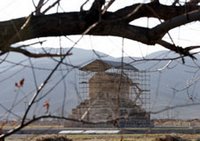Restoration of Cyrus' Tomb Started in Pasargadae

Tehran, 29 May 2006 (CHN) -- Restoration of the tomb of Cyrus the Great, the Achaemenid king, has started in Pasargadae historical site in Fars province by removing very giant stones. This project which involves 10 restoration experts aims at preventing possible damages to this ancient monument by humidity.
“Studies on the condition of Cyrus’ Tomb and its susceptibility had already started last year, and following that the restoration project of this Achaemenid monument was planned. About 30 years ago, some parts of this monument were restored by an Iranian expert. However, since the material which was used in the restoration was cement, and cement and stone do not stick together for a long time, the cracks appeared once again through which the raindrops leaked into the tomb and caused more damages to the monument. In this restoration project we will try to prevent any water leakage by closing the cracks,” said Mohammad Hassan Talebian, head of Parse-Pasargadae Research Center.
The restoration work started with the ceiling of this historical monument and experts believe that the restoration of the ceiling will be completed by the end of winter.
“Some stones had been removed during the previous restoration work. This time we also have to remove some giant stones and put them back to their original place. The exact place of the stones will be determined by the metal braces used in the construction of the tomb,” said Hassan Rahsaz, restoration expert and head of restoration team of Cyrus’ Tomb.
So far, experts have relocated three stones of the ceiling, weighing more than 2 tons each.
“This year we are intending to pay a special attention to the Tomb of Cyrus and Pasargadae historical site. Therefore, for us this year is the year of Pasargadae,” added Talebian.
Pasargadae historical site is located 87 kilometer northeast of Persepolis in Fars province of Iran. Pasargadae was an important city during the Achaemenid era (648 BC–330 BC) and was the first capital of the Persian Empire. It was construction by the order of Cyrus the Great around 546 BC but was left uncompleted due to death of Cyrus in a battle in 529-530 BC.
Many Greek and Persian historians account that after Cyrus the Great was killed in the battle, he was brought to this place and was buried there. They also say that his tomb was constructed towards the sunset since he was fond of the unset view during his lifetime.
The tomb of Cyrus the Great has witnessed many dramatic events in the course of the history. After the conquest of Persia by Arabs in the seventh century AD, Arab armies came upon the tomb planning to destroy it. However, the talented caretaker of the grave managed to convince the Arab commander that the tomb was not built to honor Cyrus but instead housed the mother of King Solomon. This way he saved it from destruction.

0 Comments:
Post a Comment
<< Home